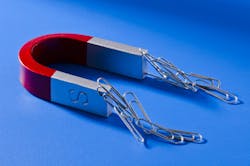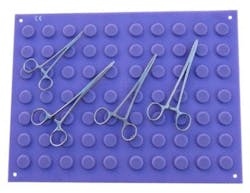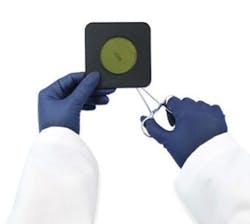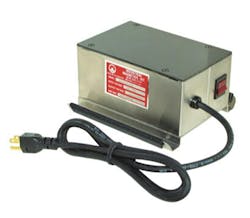Q: “Is it still recommended to demagnetize instrumentation that has become magnetized?”
A:
In a word, “Yes.” End of article.
But . . . since we have some confusion in the industry about how and/or why:
- Instruments can become magnetized
- This can be a problem
- We need to fix it
Let’s dive into more details!
How does a surgical instrument become magnetized?
The shortest and simplest answer is that our instruments can become magnetized when exposed to a magnetic field (i.e., a magnetic mat is sometimes used on the surgical field).
According to e-MagnetUK, “Magnets work because of tiny particles called electrons. These electrons spin and create small magnetic fields. In most things, these fields cancel out. However, in certain materials, like iron, the tiny magnetic fields align in the same direction.”1
A magnetized item like a magnetic pad (Fig. 1) will have an aligned magnetic field, or domain. When a metallic item (i.e., surgical needle holder) touches the magnetic field, it can rearrange the atoms and electrons to magnetize your surgical instrument to align with the magnetic domain.
This process of magnetizing surgical instruments is more easily accomplished with smaller instruments and needle holders, like those used in cardiac or ophthalmic procedures, though it can happen on larger, steel instruments as well. Instruments can also magnetize each other through rubbing and friction.
Why is magnetization of surgical instruments a problem?
When a surgical instrument becomes magnetized, metallic items will be attracted to its magnetic field.
In my experience, the most common instruments to become magnetized are small needle holders (i.e., Castro-Viejo needle holders) used in cardiac or ophthalmic procedures.
Imagine you’re observing in a cardiac or ophthalmic surgical case, as Tiffany Dailey (ST, CSPM, CSPDT, HACP-IC, and Interim Sterile Processing Leader) has many times. Tiffany scrubbed surgical cases for years, including many heart procedures.
Dailey (personal communication, June 17, 2025) stated that “A magnetized surgical instrument, such as a needle holder, can adversely impact the course of a surgical procedure in several significant ways. One primary concern is the unintended attraction of small metallic objects, such as needles, clips, or metal fragments within the operative field.
“Furthermore, the presence of magnetization can interfere with the surgeon’s ability to maintain the delicate control necessary during suturing. When a magnetized needle holder interacts with nearby metallic materials, it may jerk or pull unpredictably, diminishing the surgeon’s tactile feedback. This loss of subtle control increases the risk of inadvertent tissue trauma or improper suture placement, both of which can affect patient outcomes.
“From a sterility and safety standpoint, magnetized instruments pose additional risks. By attracting microscopic metallic debris from the operating room environment or instrument trays, this can inadvertently introduce contaminants into the sterile field. Such contamination elevates the risk of postoperative infections, jeopardizing patient recovery.
“Finally, magnetization can have a detrimental effect on the mechanical performance of surgical instruments. Components such as locking mechanisms or hinges may stick or function inconsistently due to magnetic interference.
“To mitigate these risks, it is essential to implement routine inspection and demagnetization protocols, ensuring that instruments remain in optimal condition to support successful surgical outcomes and uphold the highest standards of patient care.”
How can you test and/or fix a magnetized instrument?
A common informal quality test in sterile processing can be placing a small metallic item, often an office product like a staple or paper clip, next to or against the instrument to see if it sticks to it. The problem with this type of test is that it can create other problems. In a past Healthcare Purchasing News (HPN) article by Stephen M. Kovach (HPN, March 2024)2, Stephen relayed a story where the facility was testing their instruments for magnetization and a paper clip was left inside of the surgical tray.
There are magnetic field testers (Fig. 2) now on the market that can test your instrumentation for a magnetic field. These tests are inexpensive, easy to use, and reusable.
Once you’ve identified that your surgical instrument is magnetized, what do you do about it?
To demagnetize your instrument or needle holder, you’ll need a demagnetizer (Fig. 3) or degausser. Demagnetizers work by using electromagnets to create intense, high-frequency, alternating current (AC) magnetic fields. This shifts the magnetic field/domain randomly so that electrons are no longer aligning in the same direction.
After using the demagnetizer, test your instrument again to make sure the magnetic field is gone.
There you have it! We should be testing for magnetization of surgical instruments, which can be a problem during surgery. If magnetization is identified with a quality test, then we have tools available to fix the problem.
References:
-
Marketing. (March 1, 2024). How Does Magnetism Work & Do Magnets Lose Their Strength? e-Magnets UK. https://e-magnetsuk.com/how-does-magnetism-work-do-magnets-lose-their-strength/
-
Kovach, S.M. (Feb 24, 2024). Magnetized Surgical Instruments. Healthcare Purchasing News (HPN). https://www.hpnonline.com/sterile-processing/article/53083591/magnetized-surgical-instruments
About the Author

Adam Okada
Clinical Education Specialist, Healthmark, a Getinge company
Adam Okada has 18+ years of experience in Sterile Processing and is passionate about helping improve the quality of patient care by giving SPD professionals and their partners greater access to education and information. He has worked in just about every position in the Sterile Processing Department, including Case Cart Builder, SPD Tech I, II, and III, Lead Tech, Tracking System Analyst, Supervisor of both SPD and HLD, Manager, and now as an Educator. Adam is the owner of Sterile Education, the world’s first mobile application dedicated to sterile processing education, and a former Clinical Manager at Beyond Clean. He has published articles for HSPA’s Process magazine, is a co-chair on AAMI WG45 as well as co-project manager for the KiiP “Last 100 Yards” group, and is the former President for the Central California Chapter of HSPA. Adam is currently a Clinical Education Specialist at Healthmark, A Getinge company, where he works on Healthmark webinars, hybrid events, and educational videos, as well as the "Ask the Educator" Podcast with Kevin Anderson.



